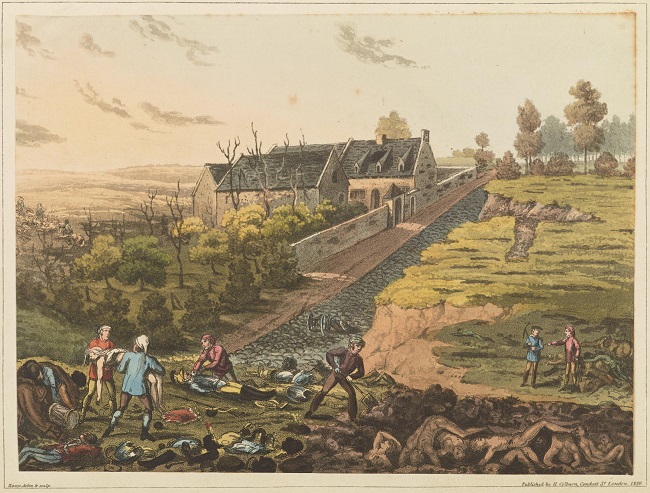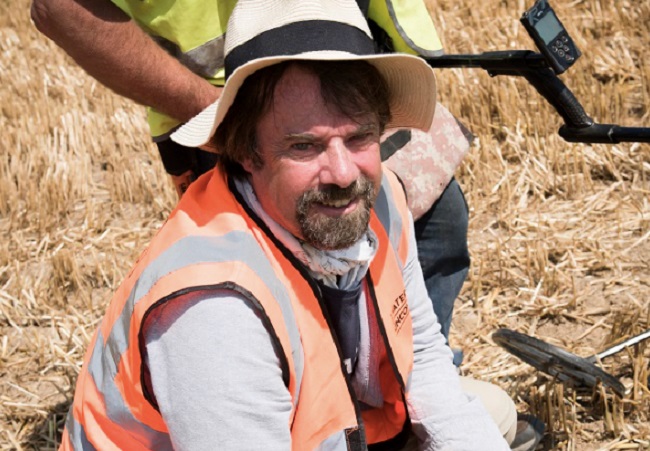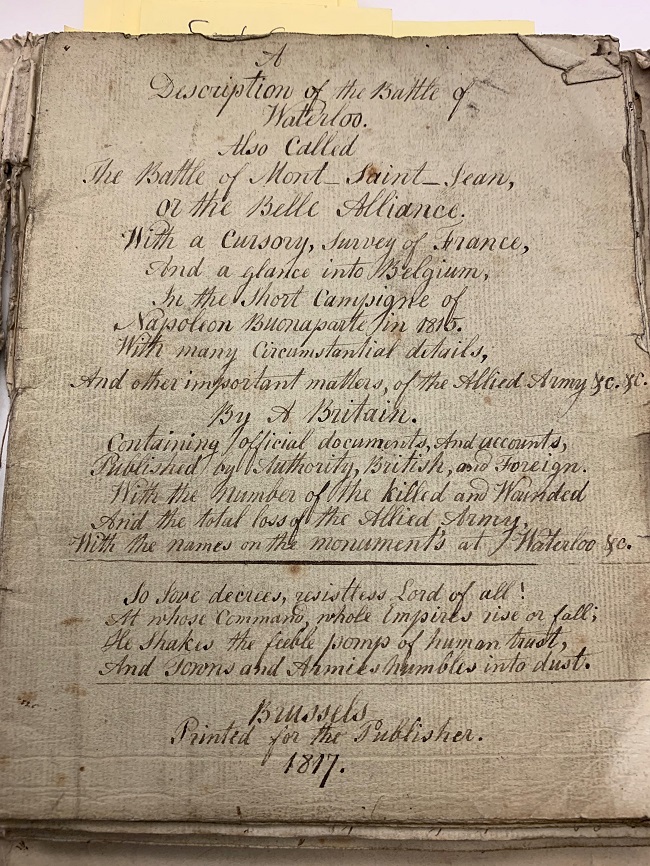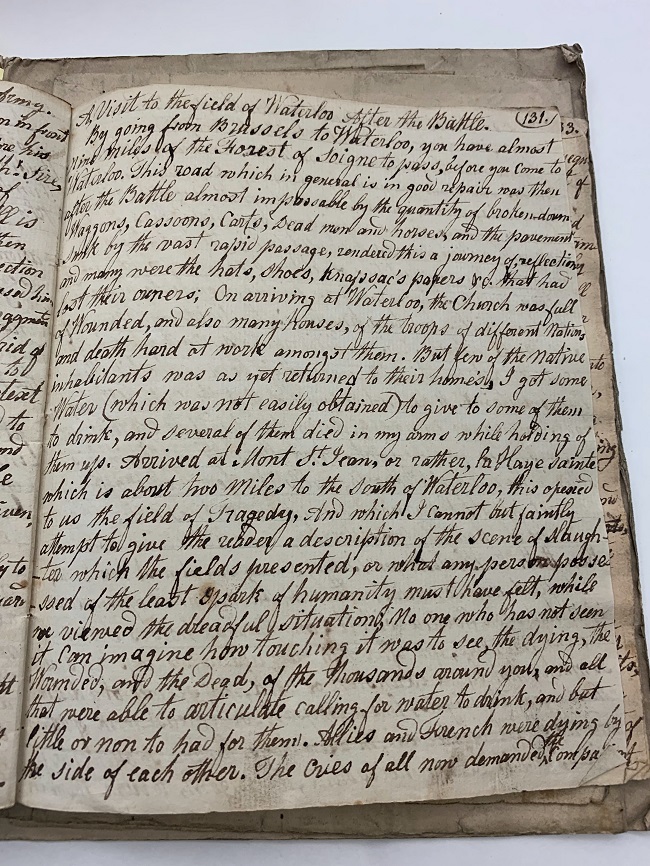First written account by civilian at the Battle of Waterloo unveiled
Published: 19 June 2023
Over 200 years after the 1815 battle, an account by Thomas Ker, a Scottish merchant living in Brussels at the time, is being published for the first time in honour of his wishes to see his account go into print.

It is considered to one of the most decisive battles of its age which changed the course of world history.
Very quickly after the Battle of Waterloo, the site became a destination not just for tourists, but leading artists and writers including Sir Walter Scott and Lord Bryon.
Now over 200 years after the 1815 battle, an account by Thomas Ker, a Scottish merchant living in Brussels at the time, is being published for the first time in honour of his wishes to see his account go into print.
In findings published today – 208 years after the historic conflict – in the peer-reviewed Journal of Conflict Archaeology, Professor Tony Pollard Professor of Conflict History and Archaeology at the University of Glasgow’s Centre for War Studies and Conflict Archaeology, says Ker was among the very earliest civilian visitors on the battlefield to have written about his experiences.
Indeed, he was so profoundly affected by what he saw that the Scot visited the Battle of Waterloo a total of 18 times over the course of a few years. The Ker collection, made up of a series of letters and a hand-written book, was donated by his family in 2018 to the University of Glasgow and is now held in Archives and Special Collections.
Professor Pollard says the Ker collection provides a valuable addition to the already rich body of work devoted to the aftermath of Waterloo. The research by Professor Pollard, who is also academic lead and a field director with the archaeological charity Waterloo Uncovered, considers the “context of previously unpublished papers, and in doing so sheds a fresh light on aspects of these early writings, including their relationship to the battlefield guidebook, which today is almost a sub-genre of military history”.

In the Journal of Conflict Archaeology, Professor Pollard writes that Ker’s letter and book ensure that “Ker writes himself into history, not by being a very early visitor to the battlefield, for there were others, but quite literally in putting pen to paper to record the experience.
“The present author has read nothing as powerful in other visitor accounts, and it proposed here that this vivid description of the dead and dying marks his experience out as very different to that recorded by those who came after him…Most of the earliest civilian accounts to enjoy publication described visits to the battlefield which took place three weeks to a month after the battle. By this time the wounded had been removed and the dead disposed of.”
Indeed Ker was there so soon after the battle, that he claims in his book to have had several men die in his arms.
Ker writes movingly of the tragedy of war: “Arrived at Mont St John, or rather La Haye Sainte which is about two miles to the south of Waterloo (the village), this opened towards the field of tragedy, and which I cannot but faintly attempt to give reader a description of the scene of slaughter which the fields presented, or what any person possessed of the least spark of humanity must have felt, while he viewed the dreadful situation. No one who has not seen it can imagine how touching it was to see the dying, the wounded, and the dead, of the thousands around you, and all that were able to articulate calling for water to drink, and but little or none to be had for them. Allies and French were dying by the side of each other. The cries of all now demanded the compassion of the bystander without exception.”

Ker’s narrative also includes descriptions of the battlefield, the clearance of battle debris, and the disposal of the dead. Professor Pollard says that from the writings he believes that “he (Ker) was on the field the day after the battle” making “him the earliest visitor known to have recorded their experiences by putting pen to paper”. Between 19 June, 1815 and 7 February, 1817 Ker made 18 visits to the battlefield.
Professor Pollard says it is fitting on the anniversary of the battle that finally 208 years later, that Ker’s work is finally published for the public to learn more.
He said: It’s obvious from Ker’s writings that being on the battlefield so soon after traumatised him. This didn’t stop him visiting the battlefield again and again though, he reckons 18 times, and this makes him by far the most regular visitor to have written about their experiences – most of the other, better known and published writings were based on single visits. As time passed, the battlefield healed, with the wounded removed, the dead buried or burned, and the debris collected up, and seeing this process advance might have helped him get over his trauma. His repeated exposure to the scene of his trauma is similar to what psychiatrists and others working with PTSD today call exposure therapy. I work with Waterloo Uncovered, which engages military veterans, some of whom have been traumatised by warfare, in the archaeological investigation of the battlefield, and despite its bloody history it is good to see the place can still have a beneficial impact on mental health and well-being.”

Other accounts are also collated and discussed in Professor Pollard’s research, including those from Sir Walter Scott, who visited the field of Waterloo in August 1815, two months after the battle. James Simpson, a lawyer from Edinburgh and an acquaintance of Sir Walter Scott, was another visitor. Charlotte Eaton, one of the earliest published visitors to the battlefield, and Newman Smith, who wrote about his day trip to the battlefield on 22 June.
The first visitors describe the whole field as being covered with soldier’s caps, shoes, gloves, belts, and scabbards, as well as books, and sentimental love-letters. These mementos, souvenirs, and trophies were collected by locals and then sold to visitors for a price. In fact British visitors regarded taking relics as an almost patriotic act, while locals who did so were depicted as ‘plunderers’
As far as trophies were concerned, the most sought after was the cuirass – a French piece of armour consisting of breastplate and backplate fastened together.
The dark tourism industry around Waterloo was so profitable, that the market was soon added to with fake artefacts. There were rumours in the years following Waterloo that, as the real artefacts dried up, so fakes were produced to keep the market alive. The most popular of these beliefs was that by the 1830s a factory in Liege was producing fake buttons by the thousands.
As time progressed there remained a market for souvenirs among the large numbers of tourists visiting the battlefield – which by 1839, according to Henry R. Addison, a veteran of the Dragoon Guards turned battlefield guide, included between 4000 to 5000 British visitors a year.
It wasn’t just the collection and sale of war relics that took place. Locals served as guides, showing visitors around the site. This provided a source of income, which made battlefield tourism a pillar of the local economy for the first half of the nineteenth century and beyond. Due to this, travel accounts and guidebooks also sprang up, giving advice on how to travel to Waterloo, where to stay and eat etc. After Waterloo, British tourists began to visit the continent in larger numbers. Belgium, then still part of the Netherlands, therefore, was a very popular destination for these new middle-class tourists, and Waterloo soon became incorporated into guidebook volumes.
Full Article in Journal of Conflict Archaeology
You can view the full article - “I have been Eighteen times since that awful day.” the Ker papers, relic collecting, and the origins of battlefield tourism at Waterloo” by Professor Tony Pollard in the Journal of Conflict Archaeology.
First published: 19 June 2023
<< News

